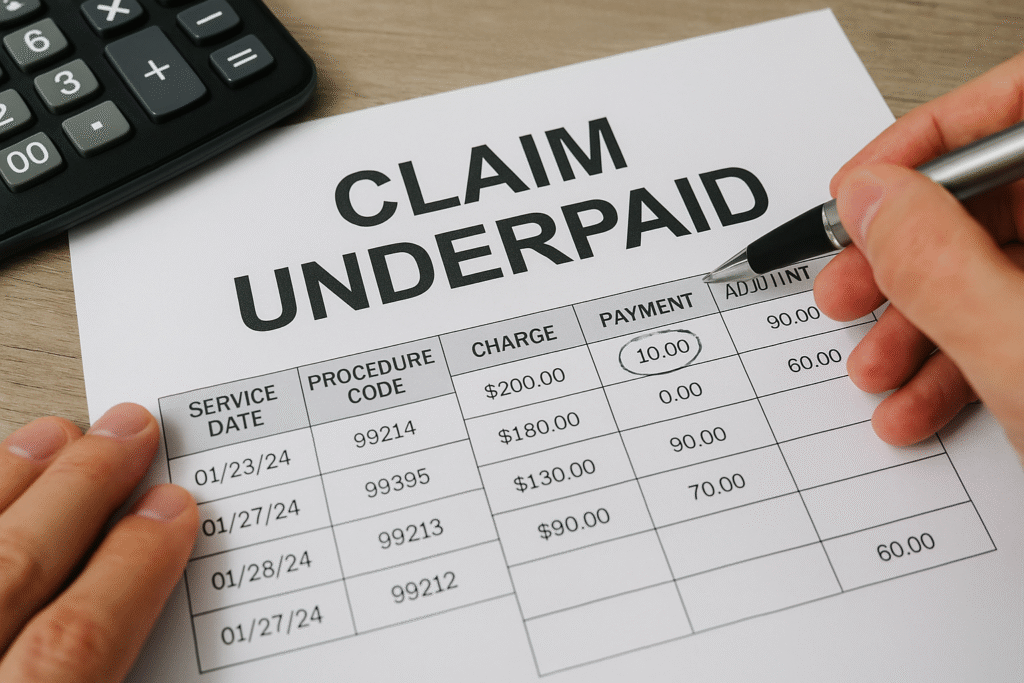
There’s nothing more frustrating than finding out that your claims are being underpaid.
Not only does this impact your revenue, but it can also affect your ability to provide high-quality patient care.
So, how do you know if your claims are being underpaid, and what can you do about it? Let’s dive into the warning signs and strategies for uncovering underpayments so that your practice gets the reimbursement it deserves.
1. Recognizing the Red Flags of Underpaid Claims
Think of underpaid claims as the silent leak in your revenue cycle — small, but they can cause significant damage over time. Here are a few red flags that might indicate your claims are being underpaid:
- Lower-than-Expected Reimbursement Rates: If you consistently notice that the reimbursement rates from insurance companies do not match your contracted rates, this is a sign of underpayment. Cross-check your payment amounts against the contracts to identify discrepancies.
- Unusual Trends in Revenue: A sudden drop in revenue or a consistent pattern of lower payments could indicate that your claims are being underpaid. Reviewing financial statements regularly can help catch these trends early.
- High Volume of Adjustments: Frequent adjustments or write-offs made by insurers can signal underpayments. These adjustments may not always be justified, so it’s essential to investigate the reasons behind them.
- Persistent Denials or Delays: When insurers frequently deny or delay claims, this could lead to partial payments or underpayments. Even if a portion of the claim is paid, the remainder may be left hanging in the balance.
2. Conducting a Thorough Claims Audit
Conducting a comprehensive audit is necessary for detecting underpaid claims.
This process can feel like finding a needle in a haystack, but with the right approach, it becomes manageable:
- Review Your Contracts: Start by reviewing your contracts with insurance companies. Make sure you fully understand the terms, including payment rates for various procedures. Knowing what you’re entitled to helps you identify when payments fall short.
- Analyze Payment Patterns: Look for patterns in your payment data. Are certain payers or types of claims consistently reimbursed at lower rates? This data-driven approach can pinpoint areas where underpayments are most likely to occur.
- Use EHR and Billing Software: Leverage your Electronic Health Record (EHR) and billing software systems to generate reports on payment trends. These tools can provide valuable insights into which claims are being underpaid and why.
3. Understanding the Common Causes of Underpayments
There are many reasons why claims may be underpaid, but here are some of the most common culprits:
- Coding Errors: Incorrect or incomplete coding is one of the primary reasons claims get underpaid. Even a minor mistake, like using the wrong modifier or diagnosis code, can result in lower reimbursement rates.
- Contractual Disputes: Sometimes, the insurance company’s interpretation of contract terms may differ from yours. This can result in reduced payments that don’t align with the agreed-upon rates.
- Fee Schedule Updates: Insurance companies periodically update their fee schedules, and failure to keep up with these changes can result in payments that don’t reflect the current rates.
- Timely Filing Issues: Submitting claims after the deadline may result in lower payments or outright denials. Each payer has its own timeframe for claim submission, and missing these can be costly.
4. Implementing Strategies to Recover Underpaid Claims
If you find that your claims are being underpaid, don’t let it slide. Taking immediate steps can help recover the revenue you’re owed and prevent future losses.
Start by appealing any claims that appear to be underpaid. Make sure to gather and include all necessary documentation, like patient records and correct coding information, to build a strong case for the appeal.
Remember, persistence is key— follow up until you get a response.
Negotiating with insurers is another vital strategy.
Reach out to the insurance companies directly to discuss any discrepancies. Use data from your audits to show where payments have fallen short and make your case for fair reimbursement.
This often requires a detailed explanation and understanding of both the contract terms and the specifics of each underpaid claim.
Strengthening internal processes is also essential. Your billing staff should be well-trained in medical coding and fully understand the unique requirements of each payer.
Regular training sessions and updates can significantly reduce errors that might lead to underpayments.
Monitoring claims regularly is a proactive approach that can catch underpayments early.
Establishing a routine review of claims and payments will help identify issues before they escalate.
5. Partnering with a Professional Medical Billing Service
Partnering with a professional medical billing service can act like X-ray vision for spotting underpaid claims.
These experts have a deep understanding of medical billing codes, payer contracts, and the appeals process, which can help you maximize revenue and streamline your operations.
Medical billing services use advanced analytics and reporting to monitor claim trends and quickly identify any potential underpayments.
They provide regular, detailed reports that highlight discrepancies and suggest corrective actions, making it easier for your practice to stay on top of your financial health.
Their expertise in payer requirements can also be invaluable. Medical billing specialists are adept at navigating the complexities of different insurance companies’ rules and regulations.
They understand what it takes to ensure that every claim is paid correctly, avoiding the pitfalls that often lead to underpayments.
Moreover, these services provide proactive claim management.
By managing claims from the initial submission through to follow-up, they help reduce the chances of underpayments while speeding up the overall reimbursement process.
This comprehensive management not only improves your cash flow but also allows you to focus on delivering high-quality care to your patients without worrying about the financial backend.

FAQ: Common Questions About Underpaid Claims
How can I identify if my practice is experiencing underpaid claims?
Look for signs like lower-than-expected reimbursement rates, unusual revenue trends, frequent adjustments by insurers, and persistent claim denials or delays.
What should I do if I suspect my claims are underpaid?
Conduct a thorough claims audit, review your insurance contracts, and use data from EHR and billing software to analyze payment patterns. Then, appeal underpaid claims and negotiate with insurers if necessary.
Why are claims often underpaid?
Claims can be underpaid due to coding errors, contractual disputes, outdated fee schedules, or late claim submissions.
How can a medical billing service help with underpaid claims?
A professional billing service can provide expertise, conduct audits, monitor trends, and manage claims proactively to recover any underpaid amounts.


